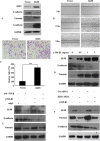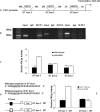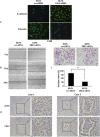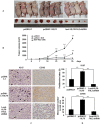KLF8 promotes tumorigenesis, invasion and metastasis of colorectal cancer cells by transcriptional activation of FHL2
- PMID: 26320172
- PMCID: PMC4694840
- DOI: 10.18632/oncotarget.4517
KLF8 promotes tumorigenesis, invasion and metastasis of colorectal cancer cells by transcriptional activation of FHL2
Abstract
The transcription factor Krüppel-like factor (KLF)8 plays an important role in the formation of several human tumors, including colorectal cancer. We recently identified four-and-a-half LIM protein 2 (FHL2) as a critical inducer of the epithelial-to-mesenchymal transition (EMT) and invasion. However, the molecular mechanism by which KLF8 affects FHL2-mediated tumor proliferation, EMT and metastasis remains unknown. Here, we showed that KLF8 overexpression promoted EMT and metastatic phenotypes. KLF8 expression was stimulated by transforming growth factor (TGF)-β1. Moreover, KLF8 acted as a potential EMT inducer by stimulating vimentin expression and inducing a loss of E-cadherin in stable KLF8-transfected cells. KLF8 overexpression induced a strong increase in FHL2 expression, and a positive correlation between the expression patterns of KLF8 and FHL2 was observed in CRC cells. Promoter reporter and chromatin immunoprecipitation (ChIP) assays demonstrated that KLF8 directly bound to and activated the human FHL2 gene promoter. However, siRNA-mediated repression of FHL2 in KLF8-overexpressing cells reversed the EMT and the proliferative and metastatic phenotypes. In vivo, KLF8 promoted FHL2-mediated proliferation and metastasis via orthotopic implantation. Taken together, this work identified KLF8-induced FHL2 activation as a novel and critical signaling mechanism underlying human breast/colorectal cancer invasion and metastasis.
Keywords: EMT; FHL2; KLF8; colorectal cancer; metastasis.
Conflict of interest statement
The authors declare no conflict of interest.
Figures







References
-
- Jackson SP, MacDonald JJ, Lees-Miller S, Tjian R. GC box binding induces phosphorylation of Sp1 by a DNA-dependent protein kinase. Cell. 1990;63:155–65. - PubMed
-
- Guo Z, Zhang W, Xia G, Niu L, Zhang Y, Wang X, Zhang Y, Jiang B, Wang J. Sp1 upregulates the four and half lim 2 (FHL2) expression in gastrointestinal cancers through transcription regulation. Mol Carcinog. 2010;49:826–36. - PubMed
-
- Abdelrahim M, Smith R, 3rd, Burghardt R, Safe S. Role of Sp proteins in regulation of vascular endothelial growth factor expression andproliferation of pancreatic cancer cells. Cancer Res. 2004;64:6740–9. - PubMed
Publication types
MeSH terms
Substances
LinkOut - more resources
Full Text Sources
Other Literature Sources
Medical

